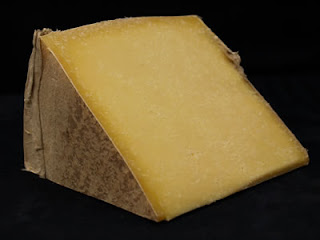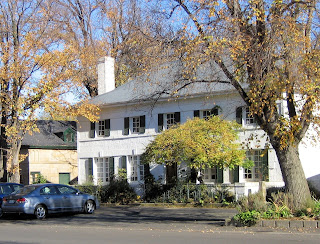On the assumption that most rooms have a window, it can reasonably be assumed that most rooms have a view of something, even if only the neighbour’s galvanised iron fence. What I have in mind however is a vista. This means, at least to me, a panorama; a landscape, seascape, treescape or hillscape to enchant the eye. A streetscape won’t suffice, although I could make an exception for the Champs Elysees.
It must be something about the drawing out of the visual field, the possibilities conjured by the ability to look to a horizon beyond your immediate reach. My reach has ever exceeded my grasp and distant fields have always looked greener, but it’s more than that. Opening a physical window to the world serves to open the mind and the imagination. What is that speck far off in the distance? A man, a wildebeest, or just that damned floating vitreous again?
Focusing on something distant works, paradoxically, to sharpen that much more intimate perspective, my thoughts. The view seems to spark off a simultaneous process of inspection and introspection. As a writer I read recently said, to paraphrase, attempting to see anything past the racket in my head is often futile, so whatever helps that process is good. To paraphrase yet again, there is something to be said for a room of one’s own, but a room with a view is infinitely superior.
This was just what greeted us as we entered The River House, a bed and breakfast establishment on the banks of the Tamar River just outside Launceston; our next port of call after leaving the Bay of Fires. From what I had read of the place beforehand, it promised to be good. However, as anyone who’s used the Internet to book accommodation knows only too well, lyrical self-promotion and stunning photo galleries can often be misleading. Not in this case though.
The River House is a gracious building set in an expansive garden which on one side slopes down to the Tamar River, affording the guest rooms sweeping views of the river frontage. The house was originally a family residence, to which substantial additions, renovations and refurbishments have been made, to brilliant effect, over the years.
On our arrival we were welcomed by the host, Carl, a charming man who made us feel at home immediately. Although having established himself in the hospitality industry only later in life, Carl has taken to his role (not to labour any puns here) like a duck to water. Not only has he mastered the art of anticipating his guests’ every need and ensuring it is promptly met, but he manages to do so in the calmly unobtrusive and unselfconscious manner of an old friend.
Leading directly off the entry foyer where the business side of arrangements are conducted, is the guest lounge, into which Carl ushered us once the formalities were out of the way. This was the room with the aforesaid view, the room that was made for me, or should have been. It was large, spacious, furnished with solid, comfortable, people-friendly sofas and chairs, and one wall of it looked directly out over manicured lawns, native shrubs, statuesque gum trees and the broad expanse of the river flowing past just a few yards away. Along one wall a welcoming fire roared in the large stone fireplace. This faced another wall lined entirely with books, which as anyone who knows me is aware are my favourite things in the world. The concept of a desert island book is one I find impossible to envisage. There's no way I’d survive anywhere without a security blanket of at least several dozen.
In terms of the room, about which I am being so unashamedly effusive, there was nothing about it that would necessarily strike others as impressive; no delicate fabrics, priceless antiques, cutting edge design, gleaming or glamorous ostentation of any description. Subtlety was probably a large part of its charm, that and taste, the acquisition of which of course, is not guaranteed by the heftiest budget. It was very much the view, but also the open fire, the bounteously stocked bookshelves, the broad chunky coffee table, the elegant lamps, the comfortable chairs and the ... well all of it. All the elements combined discreetly and seamlessly to create an ambience of peace and comfort that seemed perfectly effortless. It was the sort of place where you’re tempted to start spouting rubbish like all I need is a jug of wine, a hunk of bread and thou, so long as it’s here, and I’ll be happy forever.
No sooner had we deposited our belongings in our room, freshened up and re-oriented ourselves to our new abode, than Carl had conjured up a pot of tea and some home-made apricot slice which he set out on the table in the guest room “in case we might feel like it”. Naturally after driving all day, we did, and it was a delight to sit back and relax in the lovely surroundings. Tea eventually progressed to an evening refreshment of stronger kind and as we appeared to be the only guests in residence we were fortunate enough to have the guest room to ourselves to observe the gradual onset of dusk over the garden and the river outside.
As the shadows lengthened and crept towards the house, the river seemed to slow, along with the day, and take on a different persona, darkening and merging into its surroundings. Like rooms, there can be something magical about a body of water, changing and transforming itself constantly in response to the fluidity of the light over and around it. Looking out at this, I noticed within the shadows some deeper shadows that moved. These turned out to be wallabies, many of which live around the house and adjacent properties and come out to graze on and in some cases gobble far more than they should of the grass and shrubberies. Hard to see them as pests, with their sweet, doe-eyed faces, however they can obviously outstay their welcome, to the extent, Carl told us, they sometimes end up as wallaby pie. He and his wife, we were pleased to know, don’t discourage their marsupial visitors, seeing them as adding a bit of local colour, which they clearly do.
When we woke the next day it was to a transformed world. A feathery grey blanket lay heavily all along the river, a not uncommon phenomenon apparently on autumn and winter mornings. Because the house was situated so close to the river, the mist had expanded over the garden and everything outside the window seemed shrouded in a dense grey cloud, through which the silhouettes of bushes and trees could be discerned only vaguely. If any early rising wallabies were out there breakfasting, they would have been well camouflaged.
As we ate our breakfast, which lacked for nothing, and was enhanced by the convivial company of Carl popping in and out to ensure we were nothing less than completely satisfied, the mist lifted slightly from the garden but still hovered persistently over the river. We discovered later, when we set off down the highway which runs parallel with the river, the fog extended all along the estuary which stretches for some 70 kilometres. Because of the topography of the Tamar River valley, the area is renowned for fog which can play havoc with air and sea traffic in and out of Launceston. Indeed Launceston has the dubious honour of being the most fog-bound commercial airport in Australia.
It was with considerable reluctance that we took our leave of the River House and Carl. We didn’t meet his wife, whose role appeared to be confined to chief cook and bottle washer in the kitchen, however she certainly cooked a mean breakfast. No doubt the economic downturn has impacted on the tourism business and sustaining a small business in the industry in such times would be difficult. Carl is therefore keen to attract as much custom as possible, and encourages his guests to submit reviews of his establishment on Trip Advisor, providing they are favourably impressed, and I can’t imagine anyone who wouldn’t be. I was only too pleased to do this of course and would urge anyone who is looking for somewhere spectacular to stay to try this lovely spot. Compared to other places of comparable standard, the River House is also extraordinarily good value for money.
To check it out go to:
http://www.tripadvisor.com.au/Hotel_Review-g1488917-d1487223-Reviews-The_River_House-Dilston_Tasmania.html
Hopefully we will return one day for another taste of gracious riverside living.

































